|
Home
Hataya
Sensei DVD
Search
Bushido
Respect for Katana
Sword Dictionary
How to Guides
Bow In Ceremony
Warm Up Exercises
Bow Out Ceremony
Wearing Uniform
Formal Uniform
Wearing Daisho
Uniform Folding/Care
Katana Selection
Sword Dimensions
Sword Testing
Katana Maintenance
Katana Cleaning
Mekugi Replacement
Katana Disassembly
Is my sword sharp?
Edge Geometry
Surface Polish
Sharpening Guide
Training Basics
Kihon (Fundamentals)
8 Basic Cuts
Toyama Kata
Toyama Kukmitachi
Seitei Kata
Taikai Guides
Taikai Rules
Judging Guide
Tameshigiri
Target Prep & Spiking
Cutting Patters
Cutting Videos
Target Comparison
St Petersburg Dojo
Intro Letter
Femal Sensei
Dojo Members
Code of Conduct
Classes and Fees
Promotion Pictues
Rank Testing
Links
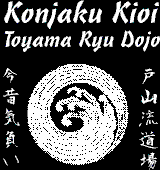
|
Katana Cleaning
Katana must be cleaned immediately after tameshigiri and at the end
of class. Unlike most decorative wall hangers - real katana rust! If
the blade is touched - it needs to be immediately cleaned unless you want to
personalize your blade with rust fingerprints.
You can find Katana Maintenance supplies at the
Nihonzashi online shop. These should also be available from most quality
stores carrying swords. We recommend using the proper supplies to minimize
risk to your investment, but we also let you know alternatives that can be used.The
dojo store offers full
sharpening, repair,
and customization
services to keep your katana in top working order.
Nuguigami: Wiping Paper for Sword Made of a soft, sensitive pulp tissue Made
exclusively for wiping your sword. Wipes off the excessive oil and unnecessary
dust. Common substitutes are soft paper towels or tissue paper (don't use
those with scents or lotion).
Wiping cloth: A flannel cloth, old towel, or hand-cloth can be used for quick
cleaning to wipe debris and residue from the blade after tameshigiri or
handling. This cloth can be reused multiple times. Nuguigami, paper
towels, or tissue paper (don't use those with scents or lotion) can also be
used, but should not be reused.
Choji Oil: A superb rust preventive oil. This is not clove oil which will
cause your blade to rust. Common substitute is camelia or mineral oil.
Oiling Cloth: Flanel cloth in a storage case used to apply a coating of choji
oil to the blade. This cloth can be reused multiple times.
Nuguigami, paper towels, or tissue paper (don't use those with scents or lotion)
can also be used, but should not be reused.
Uchiko Ball: Finely ground stone powder (hazuya and jizuya) in a silk ball.
Your should do a quick cleaning immediately after handled your sword or after
performing tameshigiri (test cutting). This cleans off any corrosive
residue off the blade.
- Prepare all the materials you need before removing the katana from the
saya (scabbard). You will not be setting the katana down and everything
you don't do here will need to be done with one hand. You will need a
wiping cloth, oiling cloth, and choji oil (sword oil). Make sure the
oiling cloth is saturated with choji oil.
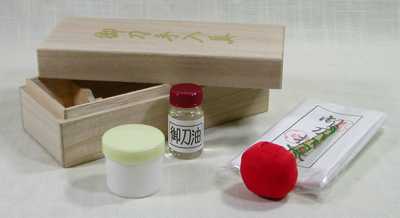
- Carefully remove the blade from the saya. The saya should be held in
the left hand and the sword should be drawn out with the right hand. The
left hand should remain motionless with the right hand doing the effort.
The sword is held edge up and the blade should slide on the mune (back surface
away from edge). The kissaki (tip) of the katana should be always be kept
pointing slightly upwards. This is a good habit since a katana may not
always have a mekugi (bamboo pin in handle) to keep the tsuka (handle) on.
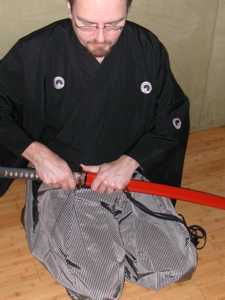
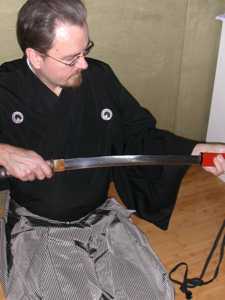
- Gently tap any debris from the saya (scabbard). Tameshigiri (test
cutting) often leaves pieces of the target on the blade and these can build up
in the saya. These can cause the blade to become corroded and eventually
cause the katana to not seat properly. The koiguchi (mouth) of the saya
can be tapped on a semi-hard surface, but care should be taken since the water
buffalo horn ring on some saya tend to fracture. The saya can then be
laid down on your left side.
- Wipe any debris and residue from the blade with the wiping cloth.
Hold the tsuka (handle) in your left hand with the ha (edge) pointed away from
yourself. Lay the wiping cloth on the top of the blade at the habaki
(blade collar). Wipe only in one direction from the tsuba (guard) to the
kissaki (tip). Use your thumb running along the mune (back of the
katana) to keep you fingers away from the ha (edge). You should only
need to wipe the blade once or twice, but make sure all residue has been
removed. Lay the wiping cloth on your hand and repeat the process on the
bottom of the blade. If your katana has bo-hi (grooves) make sure you
wipe them by pinching the wiping cloth between your fingers.
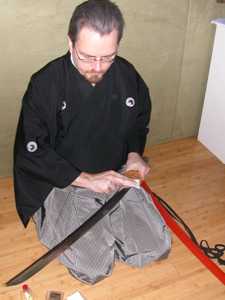
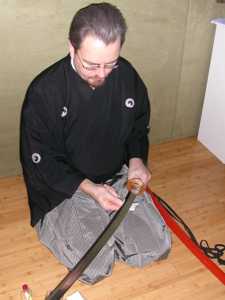
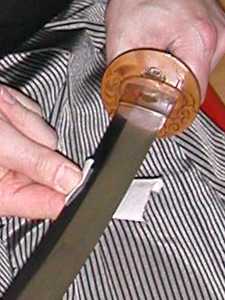
- Oil the blade using the oiling cloth. This is the same process as
the previous step. The blade only needs to be wiped once. The
entire surface of the blade needs to be covered. Try not to get too much
oil on or under the habaki (blade collar).
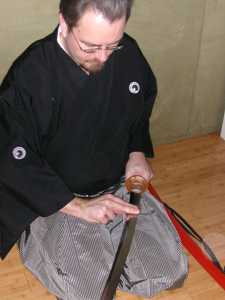
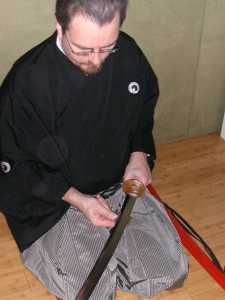
- Put the katana back in the saya reversing the process used to remove it.
The katana should not be slammed back into the saya since this can damage the
koiguchi (mouth) of the saya.
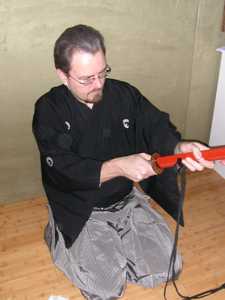 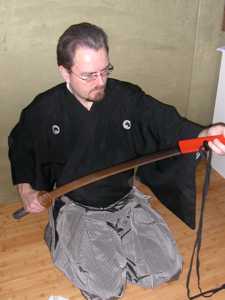
You should do a normal cleaning before putting the sword away. This
should be done at home after training.
- Prepare all the materials you need before removing the katana from the
saya (scabbard). You will not be setting the katana down and everything
you don't do here will need to be done with one hand. You will need two
pieces of nuguigami (wiping paper), oiling cloth, choji oil (sword oil), and
an uchiko ball (cleaning powder). Make sure the oiling cloth is
saturated with choji oil.

- Carefully remove the blade from the saya. The saya should be held in
the left hand and the sword should be drawn out with the right hand. The
left hand should remain motionless with the right hand doing the effort.
The sword is held edge up and the blade should slide on the mune (back surface
away from edge). The kissaki (tip) of the katana should be always be kept
pointing slightly upwards. This is a good habit since a katana may not
always have a mekugi (bamboo pin in handle) to keep the tsuka (handle) on.


- Gently tap any debris from the saya (scabbard). Tameshigiri (test
cutting) often leaves pieces of the target on the blade and these can build up
in the saya. These can cause the blade to become corroded and eventually
cause the katana to not seat properly. The koiguchi (mouth) of the saya
can be tapped on a semi-hard surface, but care should be taken since the water
buffalo horn ring on some saya tend to fracture. The saya can then be
laid down on your left side.
- Wipe any choji oil from the blade with a clean piece of nuguigami (wiping
paper). Hold the tsuka (handle) in your left hand with the ha (edge)
pointed away from yourself. Lay the nuguigami on the top of the blade at
the habaki (blade collar). Wipe only in one direction from the tsuba
(guard) to the kissaki (tip). Use your thumb running along the mune
(back of the katana) to keep you fingers away from the ha (edge). You
should only need to wipe the blade once or twice, but make sure all oil has
been removed. Lay the wiping cloth on your hand and repeat the process
on the bottom of the blade. If your katana has bo-hi (grooves) make sure
you wipe them by pinching the nuguigami between your fingers.



- Use the uchiko ball (cleaning powder) on the blade once the choji oil has
been removed. Choji oil will clog the surface of the uchiko ball if it
has not been removed. The uchiko ball is tapped every few inches along
the shinogi (flat surface on the top side of the blade). Uchiko is a
very mild abrasive and should not be used on aluminum iaito blades. Wipe
the uchico off the blade with a fresh piece of nuguigami using the same
process as the previous step. Note that this is the best time to view a
katana. You will need to repeat this step if you use this opportunity to
view or show your katana.
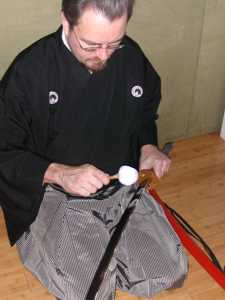
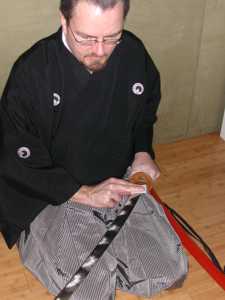
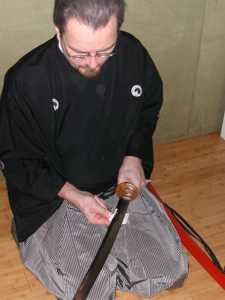
- Oil the blade using the oiling cloth. This is the same process as
the previous steps. The blade only needs to be wiped once. The
entire surface of the blade needs to be covered. Try not to get too much
oil on or under the habaki (blade collar).


- Put the katana back in the saya reversing the process used to remove it.
The katana should not be slammed back into the saya since this can damage the
koiguchi (mouth) of the saya.


|














